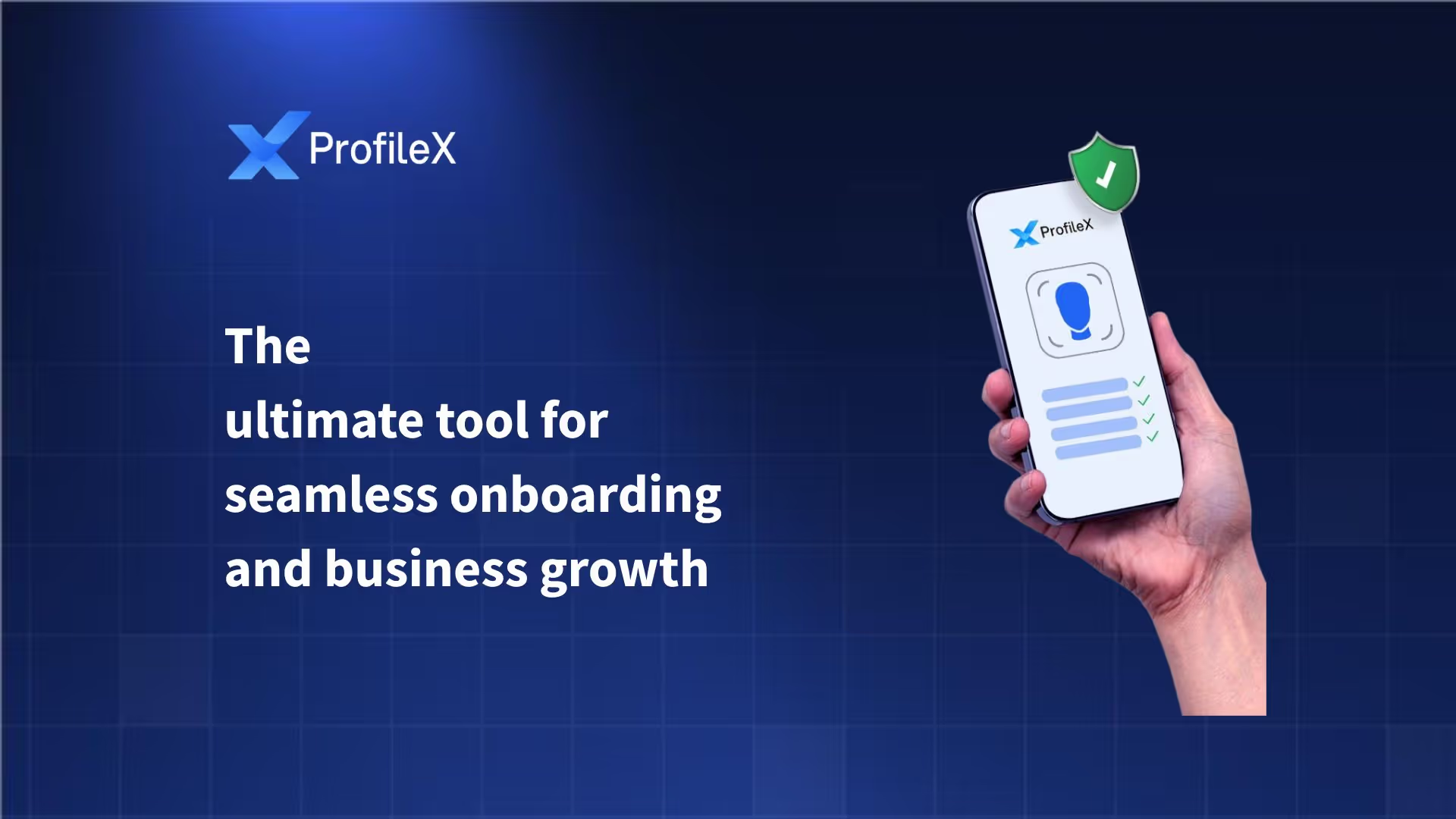KYC, or "Know Your Customer," is a standard procedure financial institutions and businesses use to verify the identity of their clients. Many financial processes like buying insurance, taking out loans, and applying for credit cards and e-commerce transactions or telecommunications verifications after sim purchases are verified using KYC
KYC involves submitting documents, such as proof of identity and current address, to a bank or any service provider offering financial or utility services. However, the manual KYC process is slow and prone to human error, which is why e-KYC, is needed.
What is e-KYC?
e-KYC, or electronic Know Your Customer, is a digital KYC process for verifying customers' identities. Industries, such as e-commerce & retail stores, financial institutions, and companies providing e-KYC services, use biometrics and digital document uploads to identify their customers faster.
e-KYC (or the Aadhaar e-KYC in India) allows these service providers to verify your identity through your Aadhaar details from the Unique Identification Authority of India (UIDAI) database.
This process uses the biometric and demographic information linked to your Aadhaar number for a quick and efficient verification. After they verify your account, you can open bank accounts, register sim cards, and do other essential things you need the eKYC verification for.
Why is e-KYC Important?
One of e-KYC’s benefits is that it reduces the time and effort required to verify your identity. Traditional KYC often requires in-person verification, which can be:
- Time-consuming
- Demands more effort
- Requires a lot of documents,
e-KYC is fast, and can be done on a laptop or a mobile. It is more secure, as it requires biometrics and multi-factor authentication. Nobody can replicate your biometric; it is unique to you, which makes your details safer.
Besides, the UIDAI only allows a few vetted organizations to carry out e-KYC verification services, so you’re in good, compliant hands.
Difference between e-KYC vs. KYC
Traditional KYC and e-KYC have an obvious difference—physical vs. online customer verification processes. Here is a rundown of the differences:
What is the List of Documents Required for e-KYC Verification?
Some important documents for digital identity verification include:
- Proof of identity through your Aadhaar or PAN card: Your Aadhaar card has a 12-digit unique identity number that is linked to the UIDAI database. The database has your demographic information (your name, date of birth, address, and other important information) and biometric data (iris and fingerprint scan). You need an Aadhaar number to enroll in any government-based service or business in India, and you can get an Aadhaar card from the UIDAI.
- Proof of address, like a driver's license or utility bill.
- A registered mobile number for verification.
- Passport
What is the Eligibility Criteria for the e-KYC Process?
Eligible individuals for e-KYC registration must:
- Be 18 years old and above;
- Have an Aadhaar number
- Be a citizen of the country where the financial institution's e-KYC service provider operates. In India, documents like Aadhaar and PAN are specific to Indian citizens, and non-citizens may need to provide alternative documents like their passports,
- Have all the required documents needed to register for e-KYC, like a driver's license and utility bill.
What are the Benefits of Using Electronic Know Your Customer Processes?
As the financial industry goes digital, the eKYC process offers several benefits that make performing financial transactions easy. Some of the e-KYC benefits include:
- It is fast. Customer onboarding and identity verification usually take less than one second (or, in some cases, a few minutes).
- It's more accurate. e-KYC uses automated data checks to verify your identity and a digital document verification system to reduce the risk of human error.
- It's a cheaper alternative. e-KYC reduces operational costs for businesses and service providers like e-commerce brands, banks, and fintech companies. Automating these processes ensures businesses can minimize the need for physical paperwork and in-person interaction, which cuts down on labor and admin expenses.
- Customers have a better user experience. You don't need to go through lengthy visits and paperwork to complete their verification, as it is done online from the comfort of your home.
What Is The Online e-KYC Process?
The e-KYC process in India is straightforward. You provide your Aadhaar number and give consent for the company or service provider to access your data from the UIDAI Database.
If you’ve registered and received an Aadhaar card, The UIDAI already has your address, and identity details, and the service provider can access it from there.
If you're using a PAN card, the service provider will require consent to verify your identity with the Income Tax Department's records. Once you’ve been verified, the system may prompt you for a final confirmation via biometric scan or an OTP to your email address or a registered mobile number.
Types of Aadhaar e-KYC
Aadhaar e-KYC uses several methods to verify a user’s identity, including the Aadhaar OTP-based e-KYC and Aadhaar biometric-based e-KYC.
1. Aadhaar OTP Online Application
To complete the Aadhaar OTP online application, you only need to provide your Aadhaar number to the service provider. An OTP (one-time password) will be sent to your registered mobile number, and you’ll input the OTP into the system to complete the verification.
2. Aadhaar-Based Biometric Online Application
This method requires more than your Aadhaar number. Aadhaar-based biometric e-KYC requires customers to provide biometrics like their fingerprint or iris scans into the system. The service provider runs the biometric data through the UIDAI database to confirm customers’ identity, and verification is completed. This method is more straightforward and secure, considering each person’s biometric data is different.
What are Aadhaar paperless offline e-KYC?
Aadhaar paperless offline e-KYC is a method for verifying identity that allows customers to complete the process without needing to go online or have real-time access to the Aadhaar database. This method enables service providers to verify your identity even without internet connectivity.
How?
- Log into the UIDAI website.
- Download a UIDAI-signed XML file containing your demographic details.
- Share the XML file with the service provider for e-KYC verification— you can upload it on their portal.
- The service provider will verify the details in the XML file against the details you provided.
- Your identity is confirmed after successful verification without needing real-time access to the Aadhaar database.
This Aadhaar e-KYC process gives customers control over when and where to share their Aadhaar details. It also doesn't require internet connectivity during the e-KYC implementation.
Understanding offline e-KYC
Offline e-KYC methods allow users to complete their KYC verification without internet access, and customers using offline KYC can get verified in three ways:
QR Code Scan
Here, service providers can scan the unique QR code on the customer’s physical Aadhaar card or a downloaded one from the UIDAI website. The QR code has all the user’s information that the service provider may need. The scanner will decrypt this data and display it for verification.
Aadhaar App
You can download the Aadhaar app from Apple or Play Store and select the offline e-KYC option on the app. The app will generate the XML file, and you can share it with the company.
Paperless Offline KYC
The customer can log in to the UIDAI website and download their XML file with their Aadhaar number and an OTP. The customer can then share the file with the service provider. Customers using the Paperless offline KYC method don't need to reveal their Aadhaar number or provide any biometric data. The only thing required is the UIDAI-signed XML file.
Aadhar e-KYC and Government Regulations
The Indian government has established a comprehensive regulatory framework to govern the use of Aadhaar e-KYC processes. The Aadhaar Act of 2016, mandates that Aadhaar numbers can be used for verification only with the individual’s consent.
The Government has charged the UIDAI to ensure adequate measures are taken to protect people's data from unauthorized access and that agencies adhere to e-KYC compliance. As such, the Aadhaar and Other Laws (Amendment) Act, 2019, has set new rules to allow only private entities verified by the UIDAI to provide KYC verification services. The UIDAI ensures that these private entities follow the e-KYC regulations and that people's Aadhaar data is not misused.
What Are the Limitations of Electronic Know Your Customer?
While eKYC has several advantages compared to traditional KYC, it isn't without its limitations. Some of them include:
- Potential security risk: e-KYC’s reliance on digital platforms makes it susceptible to cyber-attacks and data breaches. This is why it's important to use a secured platform that can withstand cyber attacks. The UIDAI vets these service providers to determine whether they can protect the data released to them.
- Technical issues: Regions with a poor internet connection might have a hard time completing an internet-reliant biometric e-KYC.
Challenges and Future of e-KYC
e-KYC assumes that every customer should have a certain level of digital literacy. Individuals who are not tech-savvy or do not have access to digital devices may find it difficult to complete the e-KYC process on their own.
Future Trends in Digital Identity Verification
Some of the expected future trends in e-KYC include biometric advancement, especially in technology like facial and voice recognition. The introduction of Blockchain can also provide a more secure and decentralized method to verify identity without the risk of data breaches.
Innovations and Advancements
Artificial intelligence and Machine Learning can assist e-KYC systems in analyzing patterns and detecting anomalies during the verification process. e-KYC also lets customers complete onboarding, whether for a loan application or a credit card application, remotely.
How Can Companies Implement e-KYC?
Companies that want to upscale from KYC to e-KYC must consider the following:
- Invest in the right biometrics, AI, and Blockchain technology
- Comply with regulations
- Prioritize a user-friendly interface so customers don't get frustrated during their verification process
- Train employees on the new e-KYC systems
- Ensure that the new system integrates with existing systems, like the customer relationship management (CRM) system
- Review and update their systems against any technical issues or security vulnerabilities
- Maintain transparent communication with customers about their e-KYC process, including how it works and how their data will be protected
Conclusion
e-KYC provides a better user experience and convenience to internet users who need to carry out financial transactions. And while it's an easier and faster way to verify customers, using a trusted e-KYC provider for these processes is crucial. NeoKred is a fintech company with a progressive e-KYC solution that provides security checks and ID verification to simplify user onboarding. Our digital technology helps businesses in the BFSI sector maintain a secure and efficient verification process for both businesses and customers.
FAQs
e-KYC, or electronic Know Your Customer, is a digital process for verifying customers' identity.
Yes, e-KYC is secured through encryption, biometric verification, and multi-factor authentication
Aadhaar authentication verifies with customers’ Aadhaar number and either OTP or biometrics, while Aadhaar e-KYC accesses the customer’s information from the UIDAI database.
Visit the service provider's e-KYC portal, enter your Aadhaar number, and verify your identity with OTP or biometric authentication.
Log in to the service provider portal, and navigate to the section for checking the e-KYC status on your progress or completion details.
Log into the service provider portal, update the necessary information, upload the required documents for verification, and then submit the changes for approval.
With e-KYC, you have access to faster processing times, improved security, and more accurate verification.





